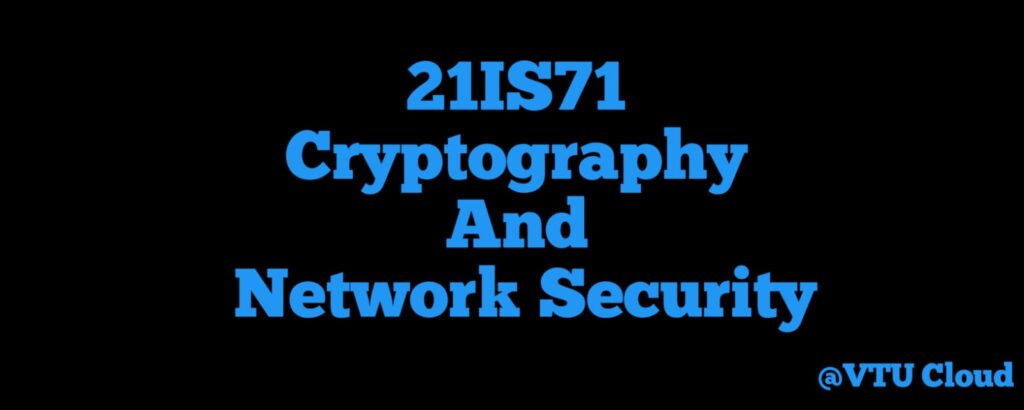21IS71 Cryptography And Network Security

Course Learning Objectives
CLO 1. To understand Cryptography, Network Security and its principles
CLO 2. To Analyse different Cryptography algorithms
CLO 3. To Illustrate Public and Private key cryptography
CLO 4. To Explain Key management, distribution and certification
CLO 5. To understand necessary Approaches and Techniques to build protection mechanisms in order to secure computer networks.
SYLLABUS COPY
MODEL PAPER
MODULE - 1
Classical Encryption Techniques Symmetric Cipher Model, Cryptography, Cryptanalysis and BruteForce Attack, Substitution Techniques, Caesar Cipher, Monoalphabetic Cipher, Playfair Cipher, Hill Cipher, Polyalphabetic Cipher, One Time Pad. Block Ciphers and the Data Encryption Standard Traditional block Cipher structure, Stream Ciphers and Block Ciphers, Motivation for the Feistel Cipher structure, the Feistel Cipher, The data encryption standard, DES encryption, DES decryption, A DES example, results, the avalanche effect, the strength of DES, the use of 56-Bit Keys, the nature of the DES algorithm, timing attacks, Block cipher design principles, number of rounds, design of function F, key schedule algorithm
MODULE - 2
Public-Key Cryptography and RSA Principles of public-key cryptosystems. Public-key cryptosystems. Applications for public-key cryptosystems, requirements for public-key cryptosystems. public-key cryptanalysis. The RSA algorithm, description of the algorithm, computational aspects, the security of RSA. Other Public-Key Cryptosystems Diffie-Hellman key exchange, The algorithm, key exchange protocols, man in the middle attack, Elgamal Cryptographic systems
MODULE - 3
Key Management and Distribution Symmetric key distribution using Symmetric encryption, A key distribution scenario, Hierarchical key control, session key lifetime, a transparent key control scheme, Decentralized key control, controlling key usage, Symmetric key distribution using asymmetric encryption, simple secret key distribution, secret key distribution with confidentiality and authentication, A hybrid scheme, distribution of public keys, public announcement of public keys, publicly available directory, public key authority, public keys certificates.
MODULE - 4
X-509 certificates. Certificates, X-509 version 3 Public key infrastructure. User Authentication Remote user Authentication principles, Mutual Authentication, one-way authentication, remote user Authentication using Symmetric encryption, Mutual Authentication, one-way Authentication, Kerberos, Motivation, Kerberos version 4, Kerberos version 5, Remote user Authentication using Asymmetric encryption, Mutual Authentication, one-way Authentication.
MODULE - 5
Electronic Mail Security Pretty good privacy, S/MIME, IP Security: IP Security overview, IP Security policy, Encapsulating Security payload, Combining security associations, Internet key exchange.
Course outcome
CO 1. Understand Cryptography, Network Security theories, algorithms and systems
CO 2. Apply different Cryptography and Network Security operations on different applications
CO 3. Analyse different methods for authentication and access control
CO 4. Evaluate Public and Private key, Key management, distribution and certification
CO 5. Design necessary techniques to build protection mechanisms to secure computer networks
Suggested Learning Resources
Textbooks 1. William Stallings: Cryptography and Network Security, Pearson 6th edition. Reference 1. V. K Pachghare: Cryptography and Information Security, PHI 2nd Edition
2. BehrouzA.Foruzan, Cryptography and Network Security, Tata McGraw Hill 2007.